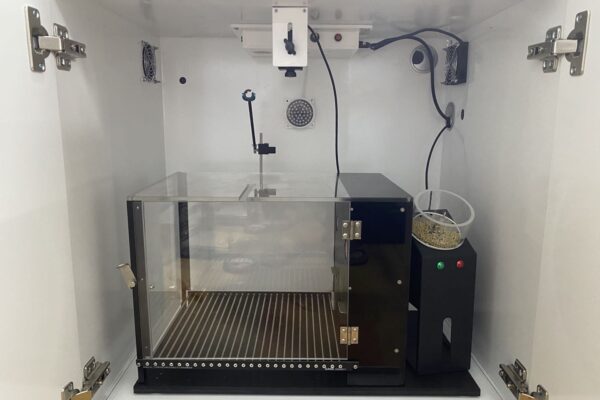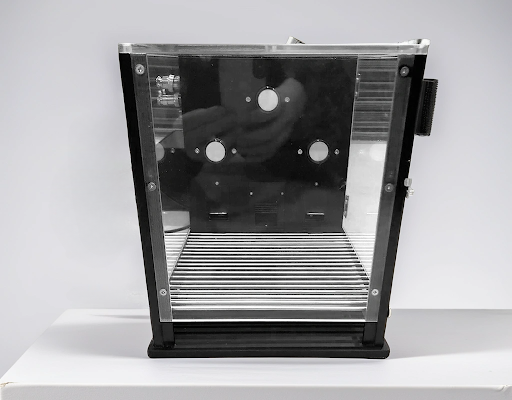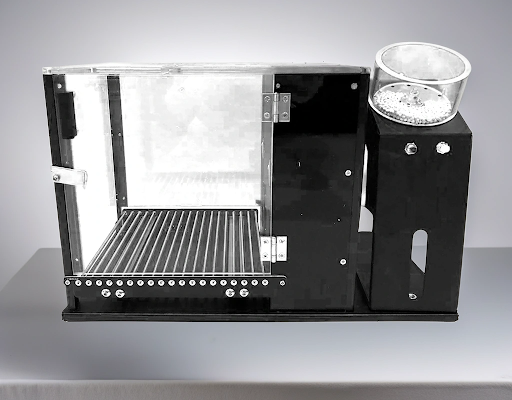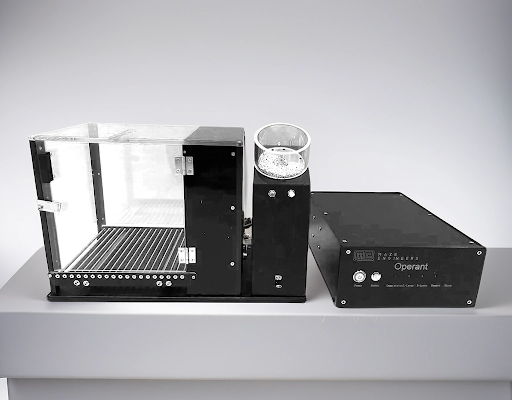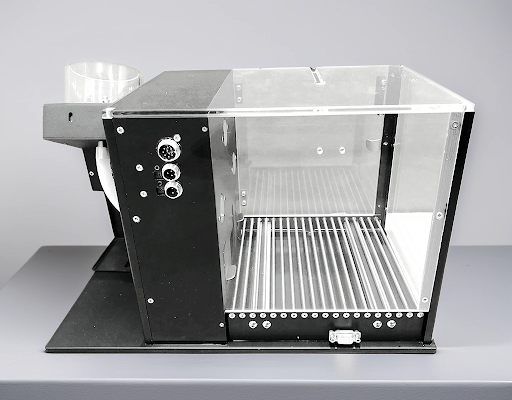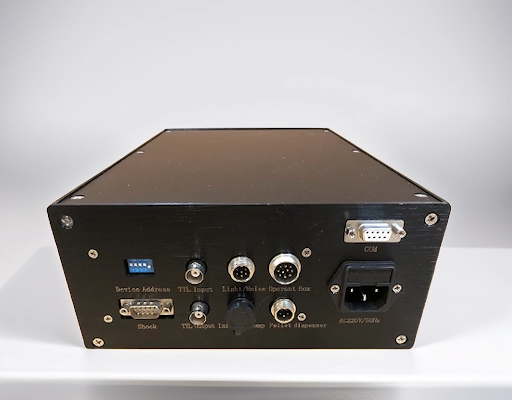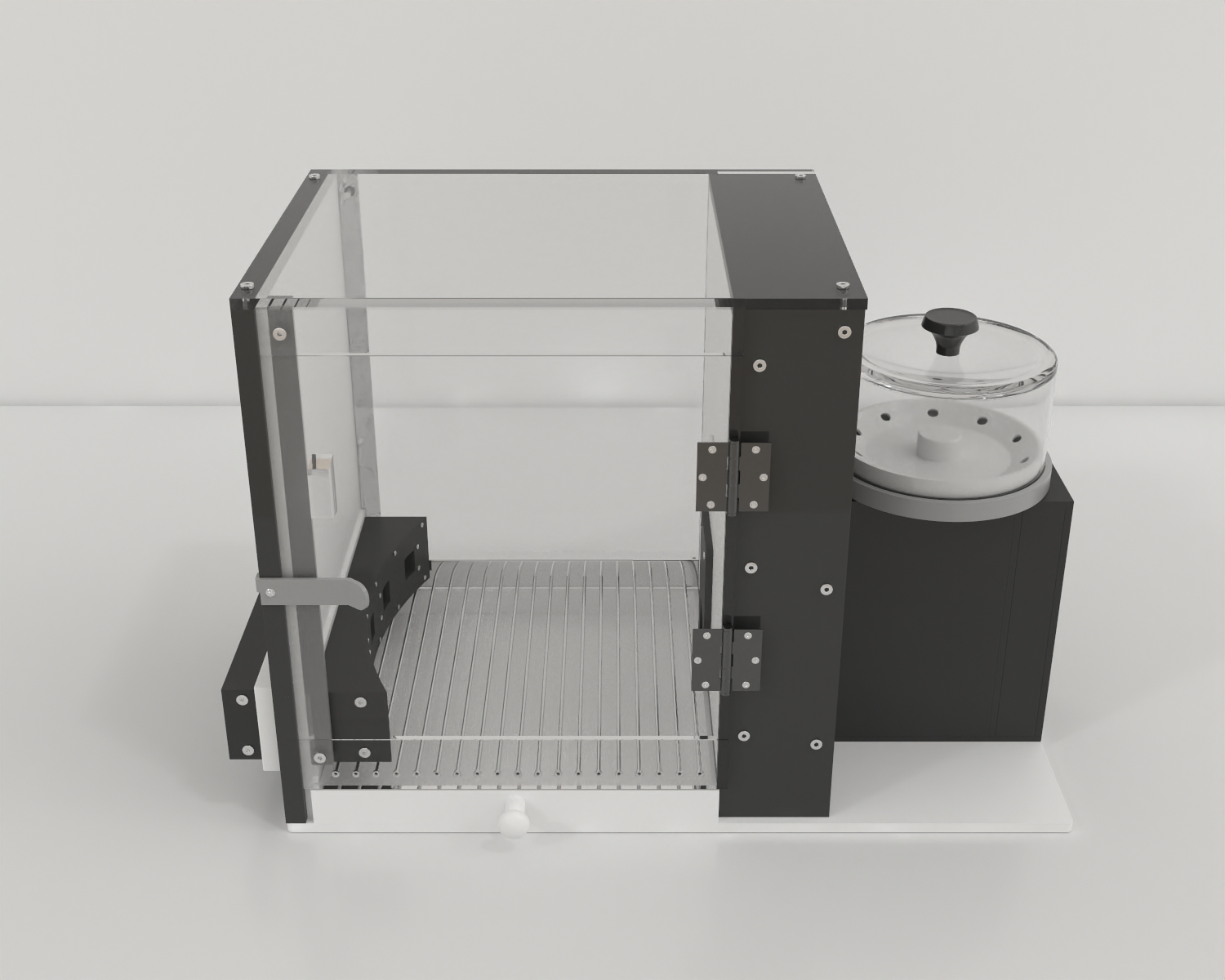See our images of the various configurations and accessories available for the Operant chamber
The rodent operant conditioning chamber is used to assess reward-seeking or aversive behaviors. Our chamber offers everything needed for operant assessments associated with voluntary goal-directed actions based on the repercussions of previous occurrences.
Maze Engineers offers the default operant chamber for mice or rats with 1x pellet dispensers and receptacle, 2x LED lights, 2x Mouse/Rat retractable levers, 1x automated LED house light, 1x shock grid, 1x chamber, and our Conduct software package for protocol set-up. This chamber is highly customizable with a huge range of add-ons and accessories (see below). For example, the option for an optic sensor to detect nose pokes can be added or pellet dispenders to be replaced with Lickometers.
MazeEngineers offers the Operant Chamber.
Price and Specifications
Mouse
$ 7890
Per Month- Chamber size: 18cm (l) x 18cm (w) x 20cm (h)
- (2x) Retractable levers or nose pokes
- (2x) LED visual stimuli
- (1x) Shock Grid
- (1x) Pellet Dispenser
- (1x) Pellet Receptacle
- (1x) Tone speakers
- (1x) house light
- Feces and urine tray
- Sound attenuating cubicle with (1) speaker, (1) circulation fan, (1) IR light
- Conduct Software: $1490
Rat
$ 8190
Per Month- Chamber size: 26cm (l) x 26cm (w) x 25cm (h)
- (2x) Retractable levers or nose pokes
- (2x) LED visual stimuli
- (1x) Shock Grid
- (1x) Pellet Dispenser
- (1x) Pellet Receptacle
- (1x) Tone speakers
- (1x) house light
- Feces and urine tray
- Sound attenuating cubicle with (1) speaker, (1) circulation fan, (1) IR light
- Conduct Software: $1490
Introduction
Operant behavior is a type of learned behavior where animals associate a specific event or stimulus with its consequence and willingly change their behavior. The association occurs after the animals have repeatedly faced the same outcome of the action, which is reflected in the change in the animals’ tendency to perform a certain action.
In other words, operant behavior emerges as an adaptive strategy after the consequence of a particular action is realized. Animals learn to change their behavior so that they can achieve favorable results or avoid undesirable repercussions that they learned from past experiences.
American psychologist B.F. Skinner was the first to use operant to describe the behaviors he observed in his landmark experiments in laboratory animals. Operant behavior and conditioning refine the nuance between conscious and unconscious behavioral responses, which influence psychology, and applied behavior analysis, and improve our understanding of addiction, substance dependence, child development, and decision-making.
In the case of the Operant chamber, subjects learn to avoid a lever or nose poke if they received a shock or learn to press a lever or give a nose poke if they receive a reward. Other cues can include lights and sound.
Features
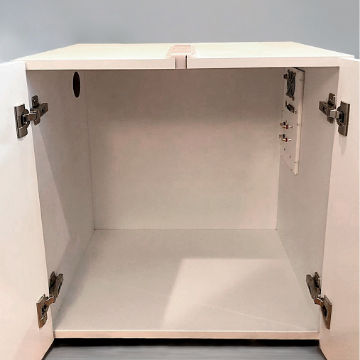
Sound attenutating chamber
Dimensions 60 x 55 x 65 cm (width x depth x height)
Multi-layer sound-proof insulation material that attenuates environment disturbance
Automated LED house light
Automated IR light
Automated air circulation fan
Camera mount
Pull-out floor shelf (optional)
Open slot for Optogenetic, cannuals, cables etc (optional)

Chamber
Acrylic walls and base (Black or grey or blue or white)
Interior dimensions: Mouse: about 20x20x20 cm (LxWxH) to fit the grid of dimension 18x18 cm, Rat: about 30x30x30 cm (LxWxH) to fit the grid of dimension 27x27 cm, Custom dimensions available
Removable lid.
Removable feces catcher for easy cleaning
House light, two cue lights, speaker, one pellet dispenser, two levers (or nose pokes) with sensor detection.
Chamber construction supports optogenetic devices
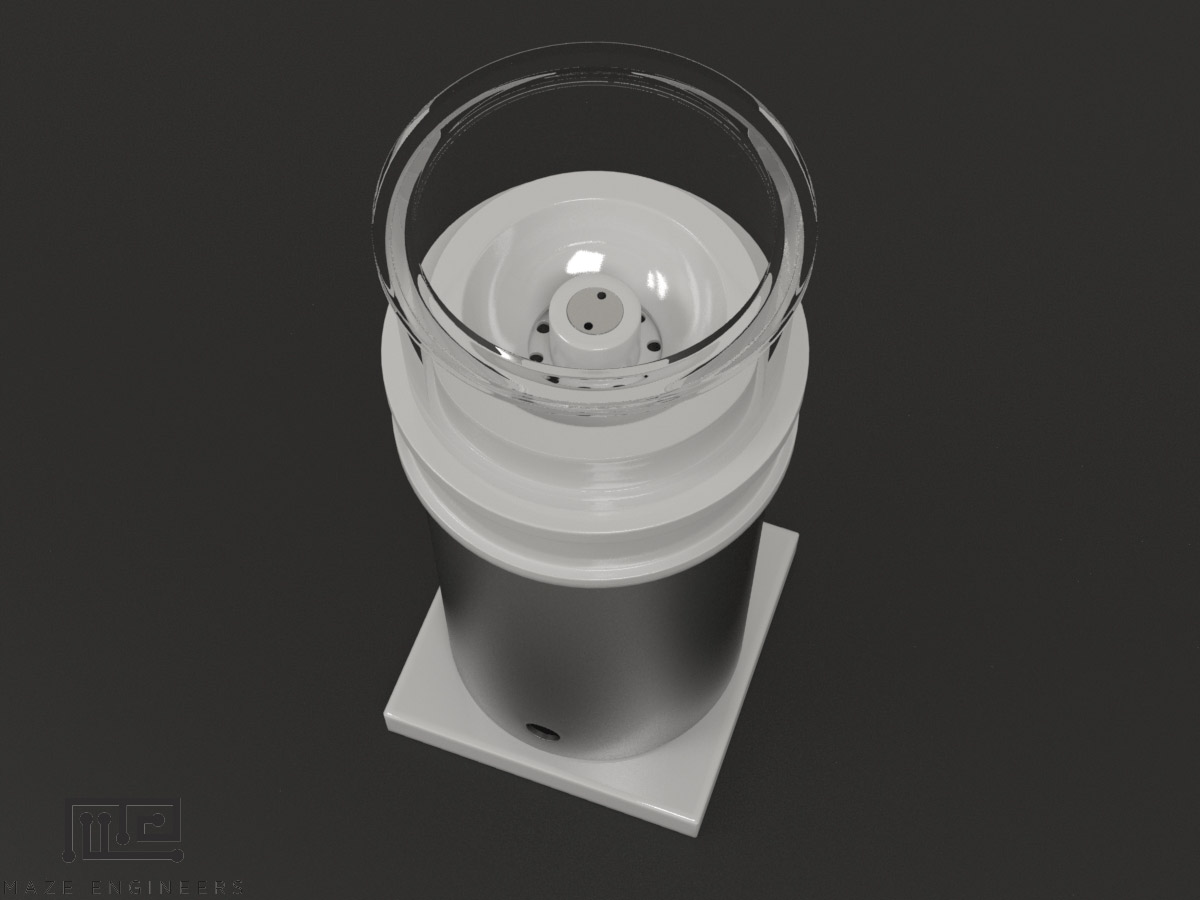
Pellet dispenser x1
The pellet dispenser is controlled by Conduct software to release pellets via protocol or lever press
20 mg pellet dispenser is the default choice (tested with pellets from Bio-Serv).
45 mg pellet dispenser is also available
Lickometers also available
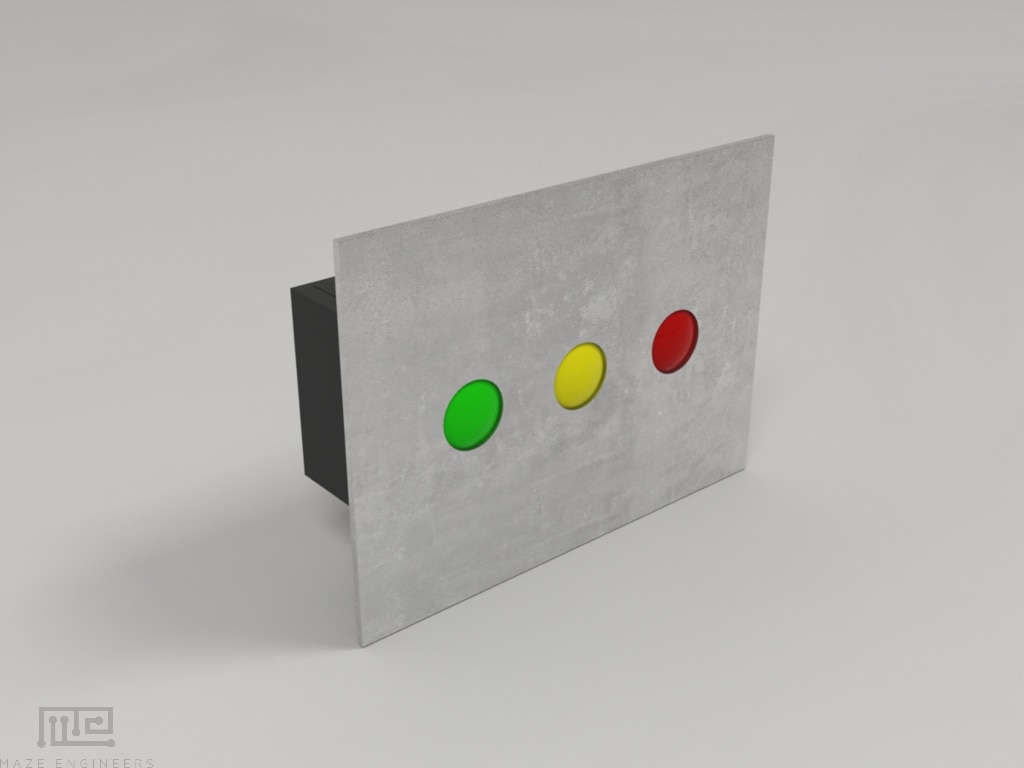
Cue lights
Each chamber is equipped with a cue light of configurable colors (white, red, green or blue)
The light on/off is controlled by Conduct software
Visible led light level 0-100, in steps of 5%
45 mg pellet dispenser is also available
Lickometers also available
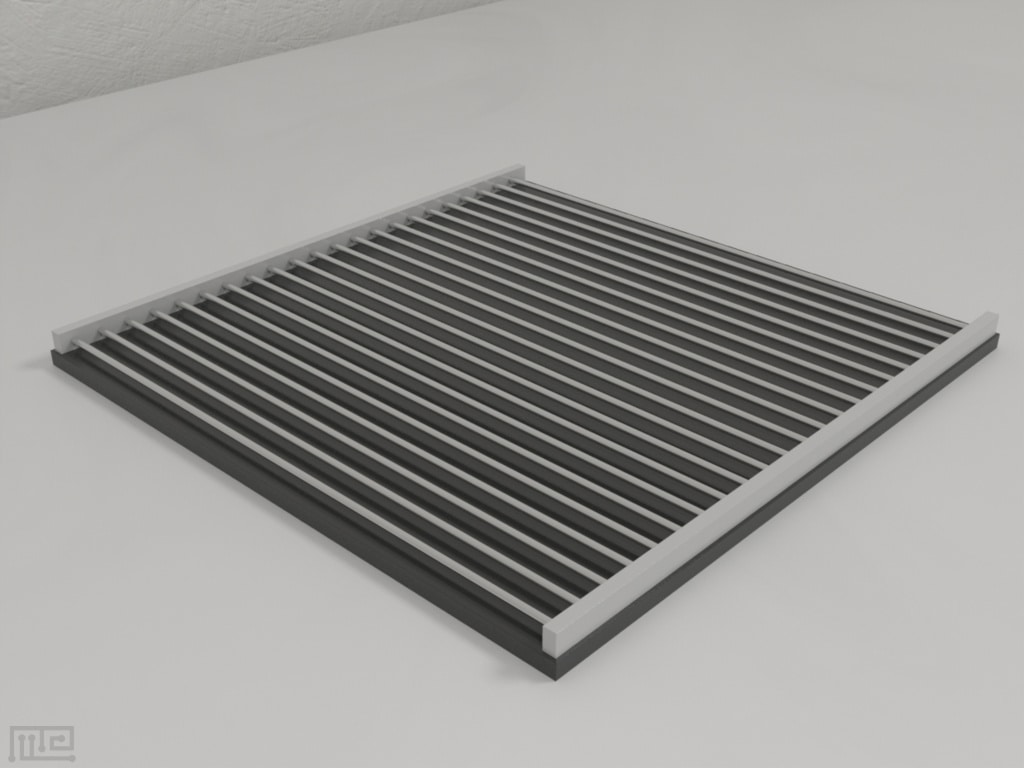
Shock grid
Shock current from 0.1 to 4.0 mA in 0.1 mA steps, programmable control
“Start/stop“ is controlled by Conduct software
Grid dimensions: Mouse: 18 x 18 cm with rod diameter 3mm and spacing 5 mm, Rat: 27 x 27 cm with rod diameter 5mm and spacing 10 cm
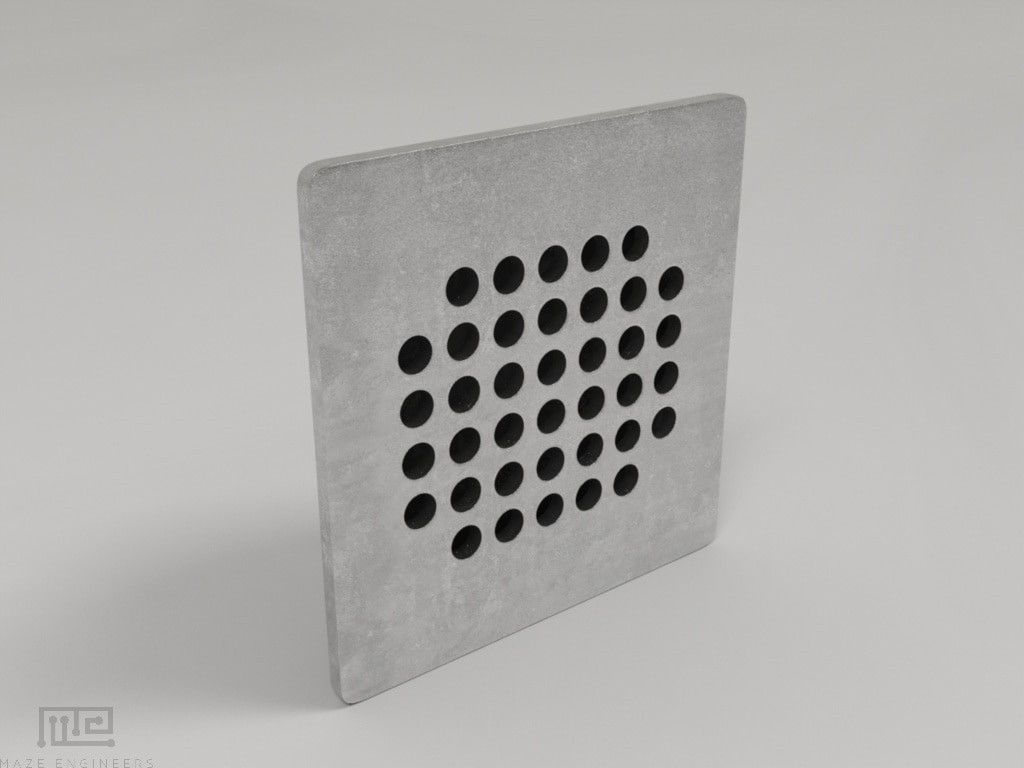
Frequency tone speakers
A speaker per chamber
Frequency tone – 100-20,000Hz frequency; volume 1-130dB
Independent sound frequency and volume control per chamber

Retractable levers
Two retractable levers are made of stainless steel mounted on the interaction panel
Width: 1.6 cm for rats and 1 cm for mice
Nose pokes also available
Don't see what you need?
Software
- Each operant chamber includes a control box to control the chamber and protocols using Conduct software.
- The main controller connects to the PC via a USB (RS-232) cable and communicates with Maze Engineers Operant software on the PC.
- The software allows the protocol setting per chamber or per group so that both control and treatment groups can be tested simultaneously with the same or different parameters.
- The software supports up to 16 chambers simultaneously
- The software allows chambers to start/stop and run independently
- Can implement many reward models including the probability model
- Maze Engineers can collaborate closely with the user to enhance software packages to their needs
- Rodent location and behavior can be tracked using a video tracking software package such as Noldus EthoVision, ANY-Maze, or BehaviorCloud.

Take advantage of Neuralynx, Ethovision Integration, SMS and Email integration with the Conductor Science Software. No I/O Boxes Required
Training Protocol
A default operant training and procedure are below.
- Experimental Setup: a. Use standard operant chambers equipped with a response lever or a nose poke device (Skinner, 1938).
- Apparatus Calibration: Ensure that the response lever or nose poke device is properly calibrated for accurate detection of responses (Bari and Robbins, 2013).
- Habituation: a. Allow the rodents to acclimate to the operant chambers for a designated period (e.g., 30 minutes) without any experimental manipulation (Panlilio and Goldberg, 2007).
- Shaping: a. Implement a shaping procedure to train the rodents to associate the response lever or nose poke device with a reward (e.g., food pellet or sucrose solution) (Bardo et al., 1996).
- Training Schedule: a. Determine a training schedule based on the specific experimental paradigm (e.g., fixed ratio, variable ratio, or progressive ratio) (Richardson and Roberts, 1996).
- Task Execution*: a. Present the trial stimulus or cue, such as a light or sound, to indicate the availability of a response opportunity. b. Record the rodent’s response (lever press or nose poke) using appropriate software or data collection systems. c. Provide a reward (food pellet or liquid reward) contingent upon the correct response (reinforcement). d. Optionally, incorporate punishment or aversive stimuli for certain experimental designs (Pelloux and Everitt, 2016).
- Data Analysis: a. Analyze the recorded data to assess the rodent’s response rate, accuracy, and other relevant parameters. b. Utilize appropriate statistical tests to compare different conditions or treatment groups (Dalley et al., 2011).
*Training schedules can be based on reinforcement or punishment with time or ratio-based protocols.
Time-based reinforcement schedules:
- Fixed Interval (FI) or inner reinforcement time-based reinforcement schedules, supply reinforcers and/or punishers at a predictable time after the trigger and target behavior.
- Variable Interval: Also known as trial time-to-reinforcement or peak procedures where the time between receiving a stimulus and reinforcers or punishers are variable.
- This protocol is the simplest to perform but is more susceptible to extinction (Spielman et al., 2014).
Ratio-based schedules:
- A ratio schedule uses the number of responses as a marker for the delivery of reinforcers or punishers, which can be arranged as fixed or variable.
- In a fixed ratio schedule, the number of times that subjects perform the target behavior before they are awarded the clearly defined reward.
- In the variable ratio schedule, the award is given for the target behavior after an unspecified number of times it is displayed. In other words, the subject learns to associate the target behavior with a reward but do not know how often they must perform the task before the reward is realized.
- This type of reinforcement schedule is regarded to be the most constructive and least prone to extinction (Spielman et al., 2014).
Data Analysis
Data analysis which can be performed with the operant chamber includes:
- Number of active lever presses/nose-pokes
- Number of inactive lever presses/nose-pokes
- Correct/incorrect lever presses/nose-pokes
Literature Review
A novel operant task to assess social reward and motivation in rodents
Borland et al. introduced a novel operant task designed to assess social reward and motivation in rodents. The authors aimed to develop a behavioral paradigm that could effectively evaluate the reinforcing properties of social interactions in rodents.
In the experiment, the authors utilized an operant conditioning chamber equipped with two response levers, each associated with a distinct social stimulus. The social stimuli included a conspecific (another rodent) and an inanimate object (a ball). The rodents were trained to respond on the lever associated with the social stimulus to obtain access to that stimulus.
The authors systematically manipulated different aspects of the task, such as the duration and intensity of social interactions, to investigate their effects on the rodents’ motivation to obtain social rewards. They also assessed the preference for social rewards over non-social rewards by comparing the response rates between the levers associated with the conspecific and the ball.
The results of the study demonstrated that the novel operant task effectively captured social reward-seeking behaviors in rodents. The rodents exhibited a higher motivation and preference for the lever associated with the conspecific compared to the lever associated with the inanimate object. This study highlights the relevance of understanding social impairments observed in psychiatric disorders and its potential for evaluating the effects of therapeutic interventions targeting social reward processing.
Overall, the study presents a valuable tool for investigating social reward and motivation in rodents using an operant conditioning paradigm, providing insights into the complex nature of social interactions and their importance in rodent behavior.
Dietary 2’-Fucosyllactose Enhances Operant Conditioning and Long-Term Potentiation via Gut-Brain Communication through the Vagus Nerve in Rodents
Vazquez et al. investigates the effects of dietary 2’-fucosyllactose (2-FL), a prebiotic compound found in human breast milk, on operant conditioning and synaptic plasticity in rodents. The authors aimed to explore the potential role of gut-brain communication mediated by the vagus nerve in these effects.
The experiment involved two groups of rodents: a control group and a group receiving dietary supplementation of 2-FL. The rodents were trained using an operant conditioning paradigm to associate a specific action with a reward. The researchers assessed the rodents’ learning and memory performance through operant response rates.
The results revealed that rodents receiving dietary 2-FL showed enhanced operant conditioning compared to the control group. They exhibited faster learning and increased response rates in acquiring the rewarded action. Additionally, the study investigated the underlying neural mechanisms by examining long-term potentiation (LTP) in the hippocampus, a key region involved in learning and memory.
The findings demonstrated that rodents receiving 2-FL exhibited enhanced LTP in the hippocampus, indicating improved synaptic plasticity associated with memory formation. The study further investigated the involvement of the vagus nerve in mediating these effects. By surgically manipulating the vagus nerve, the researchers demonstrated that blocking vagal transmission abolished the enhancements in operant conditioning and LTP induced by 2-FL.
Overall, the study highlights the beneficial effects of dietary 2-FL on operant conditioning and synaptic plasticity in rodents. It suggests that gut-brain communication through the vagus nerve plays a crucial role in mediating these effects. The findings contribute to our understanding of the impact of dietary components on cognitive processes and highlight the potential importance of gut-brain interactions in learning and memory.
Summary
- The Maze Engineers Operant system can be used for a wide range of Operant Conditioning tasks
- Available in mouse, rat, or custom dimensions
- Default packages include a sound-attenuating chamber, shock grid, 2x light cues, 2x pellet dispensers and receptacles (or lickometers), cage, speakers, and software
- Build your own operant package with our customizable builder
References
Bardo, M. T., Donohew, R. L., & Harrington, N. G. (1996). Psychobiology of novelty seeking and drug seeking behavior. Behavioural Brain Research, 77(1-2), 23-43.
Bari, A., & Robbins, T. W. (2013). Inhibition and impulsivity: behavioral and neural basis of response control. Progress in Neurobiology, 108, 44-79.
Dalley, J. W., Everitt, B. J., & Robbins, T. W. (2011). Impulsivity, compulsivity, and top-down cognitive control. Neuron, 69(4), 680-694.
Richardson, N. R., & Roberts, D. C. (1996). Progressive ratio schedules in drug self-administration studies in rats: a method to evaluate reinforcing efficacy. Journal of Neuroscience Methods, 66(1), 1-11.
Skinner, B. F. (1938). The behavior of organisms. Appleton-Century.
Spielman, R.M., Dumper, K., Jenkins, W., et al. “Chapter 6.3 Operant Conditioning” Psychology, OpenStax, 2014, https://openstax.org/books/psychology/pages/6-3-operant-conditioning
Panlilio, L. V., & Goldberg, S. R. (2007). Self-administration of drugs in animals and humans as a model and an investigative tool. Addiction Biology, 12(1), 1-22.
Pelloux, Y., & Everitt, B. J. (2016). Leveraging behavioral insights to optimize behavioral interventions for addiction. Current Opinion in Behavioral Sciences, 9, 74-80.
Vazquez, E., Barranco, A., Ramirez, M., Gruart, A., Delgado-Garcia, J. M., Jimenez, M. L., Buck, R., & Rueda, R. (2016). Dietary 2’-Fucosyllactose Enhances Operant Conditioning and Long-Term Potentiation via Gut-Brain Communication through the Vagus Nerve in Rodents. PLOS ONE, 11(11), e0166070. https://doi.org/10.1371/journal.pone.0166070
Are you an academic scientist and creator?
Learn how your lab can tech transfer this and similar devices from your lab to industry.


